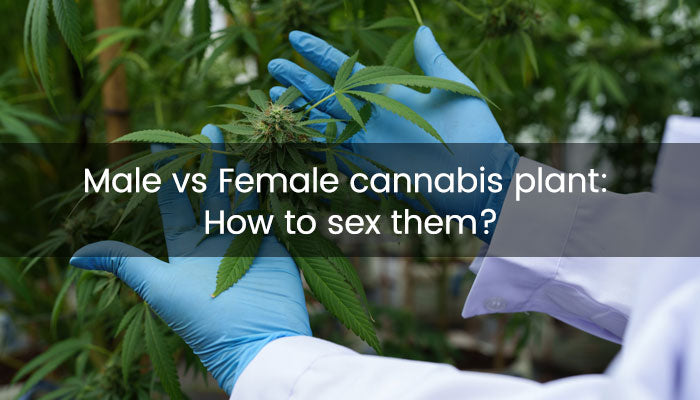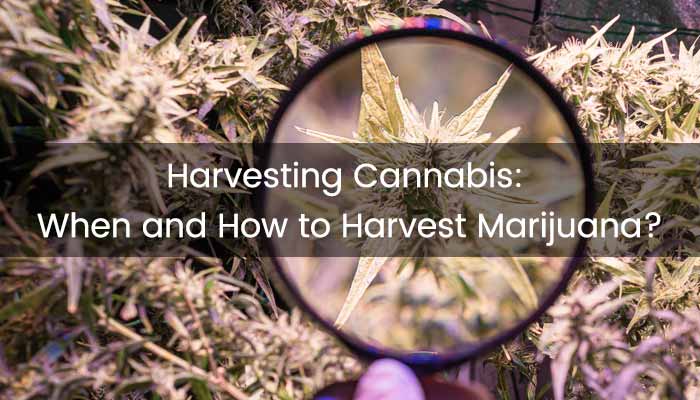Indoor cannabis cultivation is becoming increasingly popular, but many beginners may overlook a detail: sexing cannabis plants. Plant sex and cannabinoids are qualitative traits important for hemp producers and breeders.
Learning how to sex marijuana plants is key to harvesting those coveted buds. If male cannabis plants are present in the growing area, they can disrupt the flowering process of females, leading to reduced quality and yield.
But don’t worry—In this guide, Medic Grow will walk you through how to sex cannabis plants, including early signs of female plants and when they reveal their sex.
Why Sexing Cannabis Plants
In cannabis cultivation, male cannabis plants can pollinate female plants, which significantly reduces the concentration of cannabinoids, terpenes, and flavonoids in the resulting buds.
Therefore, sexing and separating male and female cannabis plants early is vital for growing cannabinoid-rich flowers and boosting yields.
Additionally, for growers and researchers focused on breeding cannabis, understanding how to sex cannabis plants helps select ideal male plants for pollination.
These selected males may possess beneficial traits such as pest resistance, drought tolerance, or higher productivity, supporting the development of superior cannabis strains.
Differences Between Male and Female Cannabis Plants
As illustrated in the table below, male and female cannabis plants differ in various aspects. If you’d like to learn more about their differences, we’ve provided additional details along with images showing the early signs of female plants.
|
Feature |
Male Cannabis Plants |
Female Cannabis Plants |
|
Primary Role |
Produces pollen for fertilizing female plants. |
Produces flowers (buds) rich in cannabinoids like THC and CBD. |
|
Pre-Flower Structure |
Develops pollen sacs that resemble small balls or clusters. |
Grows hair-like pistils (white or light-colored) at nodes. |
|
Appearance |
Taller with fewer leaves; and less dense foliage. |
Shorter, bushier, and denser foliage. |
|
Flowering Time |
Flowers earlier to release pollen for reproduction. |
Flowers later, form buds for reproduction or harvest. |
|
Yield |
Does not produce usable buds; used for seeds or fiber. |
Produces smokable, cannabinoid-rich buds for various uses. |

How to Tell Male and Female Cannabis Plants
To tell male and female cannabis plants, you can check the preflower at the nodes. This typically occurs about 4–6 weeks after germination, when the plants display subtle signs of their gender at the nodes (the junctions where branches meet the main stem).
Male cannabis plants are characterized by the formation of small, round pollen sacs at their nodes. These sacs may appear individually or in clusters, growing quickly and typically revealing themselves earlier than female plants, making males relatively easier to identify.
In contrast, female cannabis plants develop fine, hair-like pistils at their nodes. These white or pale-colored hairs are the earliest signs of budding flowers.
The pistils stand out clearly against the plant's green background, signaling that the plant is preparing to produce cannabinoids such as THC and CBD.
Additionally, using high-quality full-spectrum LED grow lights combined with cannabis nutrients can promote healthier and faster growth, enabling you to identify the plant's sex earlier and more effectively.
Early Signs of Female Plant
Female cannabis plants can be identified by early signs such as bushier growth, more side branches, and broader leaves compared to male cannabis plants. Female cannabis plants also have shorter internodal spacing and may grow slower and more compact.
Look for flowers at the nodes, which appear as tiny tear-shaped calyxes with white, hair-like pistils. These are a clear early indicator for female cannabis plants. Additionally, considering the overall health and vigor of the plant, as well as strain-specific traits and cannabis seeds' gender, can also help in identifying female cannabis plants early on.

Early Signs of Male Plant
The early signs of male cannabis plants include taller, more spindly growth with fewer side branches and narrower leaves compared to female cannabis plants. In addition, the flowers at the nodes, appearing as small, ball-shaped pollen sacs, are a clear indicator of male cannabis plants.
It's also possible to identify male and female cannabis plants by their growing habits, as male cannabis plants tend to grow faster, generally 1-2 weeks than female cannabis plants. In addition, male cannabis plants have longer internodal spacing (the distance between sets of branches) compared to female plants, with a noticeable stretch upward.
By monitoring these signs, we can identify male and female cannabis plants and take further action, such as removing the male cannabis plants to ensure higher yields and cultivating the cannabis seed you want.

What to Do with Male and Female Cannabis Plants
Once you have a clear understanding of the differences between male and female cannabis plants, you can manage them effectively using the following methods.
Male Cannabis Plant
Male cannabis plants are primarily used for breeding and seed production. If your goal is to develop new strains or produce seeds, isolate male plants from females to avoid unintentional pollination.
However, if you are cultivating cannabis for flower production, male plants should be removed as soon as identified.
Male plants do not produce the resin-rich buds sought for THC or CBD and can reduce the quality of your crop by pollinating nearby females.
Alternatively, male plants can be repurposed for hemp fiber, compost, or even juicing for their nutritional benefits.
Female Cannabis Plant
Female cannabis plants are the primary focus for growers seeking cannabinoid-rich flowers. These plants produce the resinous buds that contain THC, CBD, and other desirable compounds.
To maximize their yield and potency, provide female plants with optimal growing conditions, such as high-quality full-spectrum LED grow lights, proper nutrients, and a stable environment.
Hermaphroditic plants
Hermaphroditic plants, which develop both male and female reproductive structures, require special attention. They can form due to stress factors such as poor lighting, inconsistent watering, or extreme environmental changes. If hermaphroditic traits are identified, it’s best to remove these plants immediately to avoid accidental pollination of nearby females.
Conclusion
In conclusion, sexing cannabis early can prevent unwanted pollination and ensure a higher yield of quality buds. Whether you’re growing for personal use or on a larger scale, this knowledge empowers you to achieve successful and rewarding growth. Happy growing!
FAQs about Male and Female Cannabis Plants
1. How Soon Can You Tell if a Cannabis Plant Is Male or Female?
Around 3 to 4 weeks after germination, male cannabis plants develop small, smooth, ball-shaped pollen sacs at the nodes. Female cannabis plants take slightly longer, appearing around 4 to 5 weeks after germination, producing V-shaped white pistils at the nodes.
2. Can a Male Cannabis Plant Turn Female?
A male cannabis plant cannot change into a female plant. However, plants can exhibit hermaphroditism, where a single plant develops both male and female reproductive organs due to stress. To avoid female this, avoid disrupted photoperiods or cannabis nutritional imbalances.




